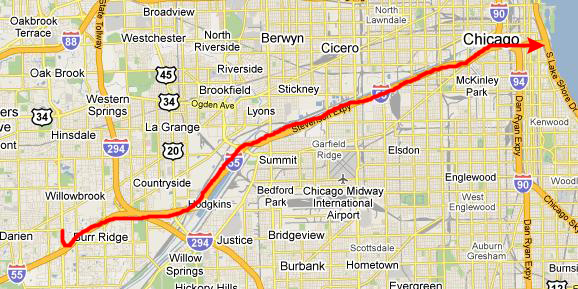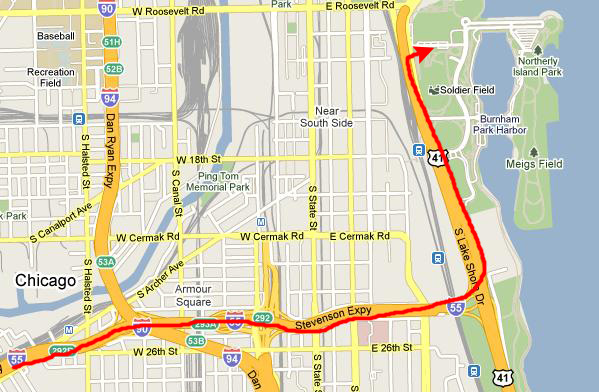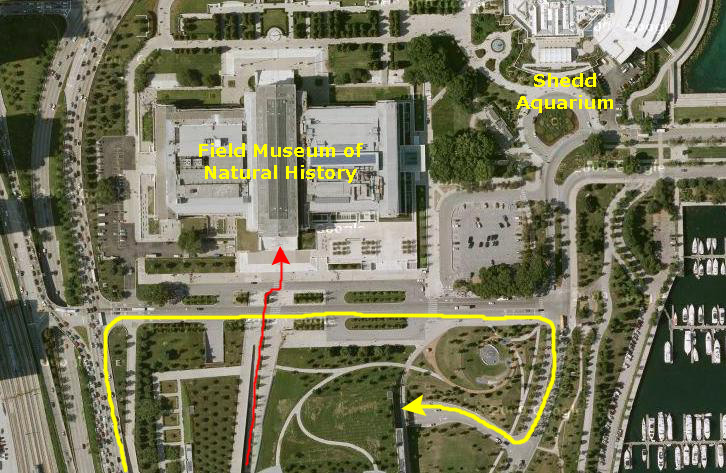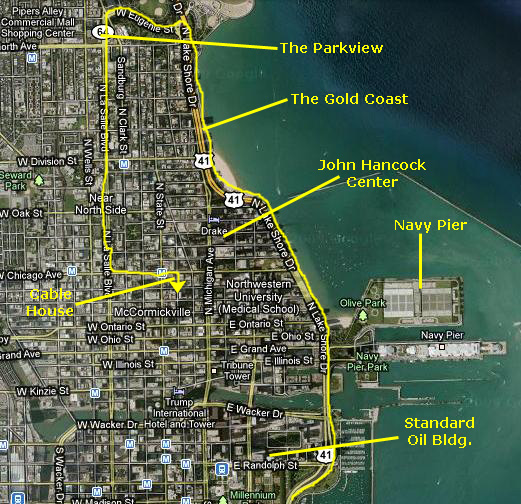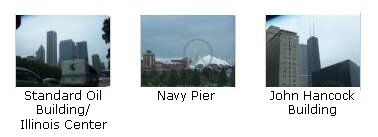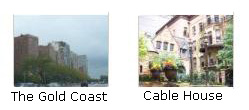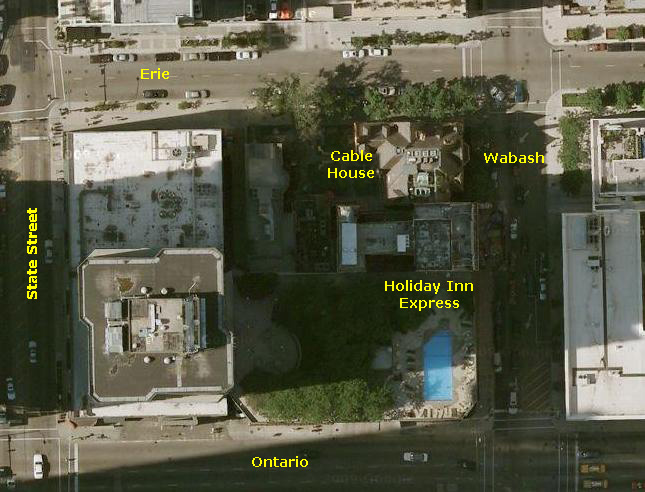 |
October 4, 2009: Chicago's Near North Side |
 |
October 1-2, 2009: The St. Louis Botanical Garden and Gateway Arch |
 |
Return to the Index for Our Midwest Trip |
October 3, 2009
Midwest Trip: Day Three
Chicago, Illinois
We Arrive in Chicago
Saturday morning dawned cold and overcast and it promised to rain during the day.
We checked out of the Super 8 and went back down the road to I-55 and continued on into Chicago. I never traveled on I-55 much; I usually went to St. Louis via I-57. The Stevenson Expressway comes into Chicago from the southwest. We crossed over one of the beltways around Chicago, I-294, and continued on through urban Chicago towards the lake shore. Eventually, we crossed under I-94 which, near downtown, runs north-south.
One of the main reasons for coming through Chicago was so that I could stop and show Fred some of the places I'd lived and worked when I was here, and also to see Gerry Vitale, my good friend and finance guy. Unfortunately, Gerry was not going to be able to get together until late in the day, and since we couldn't check into the hotel until the afternoon, we decided to go straight to the area of museums south of Grant Park and spend some time there.
The sun was peeking through the clouds when we arrived near Grant Park, which gave us hope that the weather would not be as bad as had been predicted, but since it was still iffy, being indoors seemed like a good idea.
After we turned off I-55 (the Interstate starts at this point and runs all the way to New Orleans) and headed north on Lake Shore Drive, Fred got is his first good look at part of
downtown Chicago.
We came north on Lake Shore Drive and passed Soldier Field (You can see a good picture of it taken from the steps of the Field Museum
here.
I must admit that the last time I saw it, those futuristic additions were not there; it was a much more plain stone building with columns all around.),
and then turned right in front of the Field Museum of Natural History. I couldn't find any parking on the street, so we came around into the underground garage between Soldier Field and the Museum. When we came up from underground, we were walking straight towards the museum. There was a fountain wall beside the sloping walkway up, and we stopped to take a couple of pictures. I took one of
Fred
and he took one of
me.
As we crossed the street in front of the museum, we could look to the left and see many of the
new downtown Chicago buildings.
This part of downtown has changed an amazing amount in the years since I've been gone- almost 25 now. None of the skyscrapers that you can see in this picture were here when I left, and almost all of these are residential. After admiring the view for just a minute, we crossed the street and headed up the steps into the
(Marshall) Field Museum of Natural History-
a Chicago landmark for almost 90 years.
Our Visit to the Field Museum of Natural History
The Field Museum was incorporated in the State of Illinois on September 16, 1893 as the Columbian Museum of Chicago with its purpose the "accumulation and dissemination of knowledge, and the preservation and exhibition of objects illustrating art, archaeology, science and history." In 1905, the Museum's name was changed to Field Museum of Natural History to honor the Museum's first major benefactor, Marshall Field, and to better reflect its focus on the natural sciences. In 1921 the Museum moved from its original location in Jackson Park, which is at the south end of the parkland bordering Lake Michigan, and quite near the University of Chicago, to its present site on Chicago Park District property near downtown where it is part of a lakefront Museum Campus that includes the
John G. Shedd Aquarium
and the Adler Planetarium. These three institutions are regarded as among the finest of their kind in the world and together attract more visits annually than any comparable site in Chicago. During the fifteen years I spent in Chicago, I visited all of these museums a number of times; they were one of the main attractions to living in this city. As you may be aware, the Field Museum was the setting for the first "Night at the Museum" movie.
Getting Into the Field Museum and Main Hall
We came in through the south entrance and got in the queue for admission tickets. Once in to the museum proper, we wandered around the central part of the main hall for a while, looking at our museum map and planning what we wanted to see.
As we walked the length of the main hall, Fred was impressed by some of the architectural detail that he saw here inside the museum, and took quite a few pictures. I've put thumbnails for three of these below. To see the full-size pictures, click on the thumbnail images:
As we walked down to the end of the hall, Fred photographed the totems and the elephant that you can see on the diagram, but these did not turn out well. When we got to the skeleton of Sue, the T-Rex (and usually used as the symbol of the Field Museum), we had pretty much figured out how to spend most of the day. Before we left to go to our first exhibit, I took a picture of
Fred and Sue.
|
I thought that our position at the end of the main hall by Sue was a good place to make a movie of the main floor hall of the Field Museum. The building is quite large, and this main hall is certainly impressive. |
The Ancient Egypt Exhibit
Since Fred is into ancient civilizations, we decided to have a look at the exhibit about ancient Egypt first.
To get to it, we walked down to the southwest corner of the main floor and went inside the
entrance to the exhibit.
We actually ended up inside a small, simulated Egyptian tomb entrance. We went down the
entry hallway,
the walls of which were covered in pretty authentic-looking
hieroglyphics.
At the end of the hallway and through some doors there were some narrow stairs that led downward. I assume this was to give the impression that you were actually going inside a tomb to look at the artifacts inside.
Although we didn't quite know it at the time, we had descended to the ground floor of the museum and were now in the dimly-lit exhibit. The exhibit consisted of four or five rooms of various artifacts- almost all of them the real thing.
While we walked through the exhibit, both Fred and I took pictures. Almost everything was in glass cases, and this made using the flash difficult. But without the flash, some of the pictures we took here in the dim light didn't turn out as well as we had hoped.
I've put a couple of sets of thumbnails below for the best of the pictures that we took here in the exhibit. You can click on them to view the full-size images:
|
While we were wandering through the display cases in the Ancient Egypt exhibit, I made a movie of our surroundings. |
When we came back up to the main level from the ground floor level, we next went through the Ancient Americas exhibition hall. The subject here was the land and the people of North and South America, and it was extremely interesting- particularly the parts about the peoples of the American Southwest. This area was almost entirely exhibits in glass cases, so we didn't take any pictures.
When we were finished, we'd ended up near the Corner Bakery (the same chain that you may have seen in its own stores) that had one of the cafe concessions here in the museum. We stopped to have lunch- sandwich, soup and drink.
Then we headed upstairs to see some more of the museum.
On the upper level of the museum there were two main exhibits we wanted to see. The first was called
"The Evolving Planet."
It was, essentially, a timeline that started with the emergence of life on Earth and ended at the beginning of modern human history.
The concentration in the exhibit was the evolution of life, rather than the geology of the planet, and even more precisely on the evolution of animal life. (We planned to visit the "Plants of the World" exhibit later if we have time.
Fred is very interested in archaeology, and so this would be an interesting exhibit for both of us. As it turned out, the major part of the exhibit, which wound through three major halls in the museum, going in and out of sections devoted to various topics along the timeline, were the dinosaurs- and the animals that directly preceded them and those that came fairly quickly after.
The museum has an extensive collection of dinosaur skeletons- "Sue," on the main floor, being the best representative. But there were skeletons of all sorts of dinosaurs, some quite large, and a wealth of information about them. Even with most of the afternoon at our disposal, it wasn't possible to see everything, read everything or digest everything, so we just browsed and stopped at what was interesting.
|
Click on the Image Above to View the Slideshow |
The pictures that we took simply illustrate a sampling of what there is to see; we did not attempt any exhaustive chronicle of the timeline through the exhibit. So all we can really do is show you a selection of the pictures that we did take. Due once again to the dim lighting, not all of the pictures turned out well, and we've only included here the best of the ones that did. It would have been nice to have had more time, but, as I commented to Fred, one would have to visit the museum for quite a few days to hope to see all that is here- weeks, I should think.
Anyway, I've put the best of our pictures of the skeletons in a slideshow to make it easy for you to go through them.
To view the slideshow, just click on the image at right and I will open the slideshow in a new window. In the slideshow, you can use the little arrows in the lower corners of each image to move from one to the next, and the index numbers in the upper left of each image will tell you where you are in the series. When you are finished looking at the pictures, just close the popup window.
Most of the things we saw in the exhibit were skeletons, but Fred, being interested in fossils, also took some pictures of some of the unusual fossils that we saw on our way through. Click on the thumbnail images below and you can see the full-size pictures that Fred took:
|
The Evolutionary Planet exhibit series was very interesting; a lot of thought went into it. About halfway through it, the exhibit course opened out into a rather large gallery, with lots of skeletons and other exhibits around. I made a movie in this large gallery. |
At the end of the exhibit, there was a
colorful wall of images
whose purpose was, apparently, to show the incredible variety of life that has been the result of the past billions of years of natural selection and evolution.
|
I thought that the image wall at the end of the Evolutionary Planet exhibit series was interesting enough and colorful enough that I should make sure that the photos we took of it came out. Knowing that my movies do a better job of adjusting to low light levels, I thought I would make a movie panning across the images. |
We did one more exhibit before we left the museum- the Plants of the World exhibit. This one was also right up Fred's alley, and we saw a lot of interesting plants, many of which neither myself nor, more surprisingly, Fred, had ever seen or heard of. We spent about an hour there before heading back out into the main hall and back downstairs.
Just before we left the museum to head over to the hotel, I took one last picture in the main hall, this one of a
pterodactyl
that had somehow escaped our notice before. (I know it seems as if the dinosaur is after the tiny pirates rapelling down from the ceiling.) The pirates, incidentally, were part of the promotion of the current Pirates exhibit.
Just the small part of the Field Museum that we'd had the opportunity to see today was fantastic; perhaps on another visit we can see more of what is here. But for now, it was time to get back to the car through the light rain and head over to our hotel.
Getting to Our Hotel
We ransomed the car and left the museum campus, heading north on Lake Shore Drive. We made a big loop up to The Parkview, where I had been living when I left Chicago, and back down to the Holiday Inn Express- our Hotel.
On the way, Fred took some pictures out the car window and, while the weather wasn't good, I thought I would include a few of them, keying them to the aerial view at left. You can have a look at them by clicking on the thumbnail images below:
At Our Hotel
I had intended to find a place to park on the street; I'd always had good luck when I lived in Chicago and needed to drive somewhere downtown. But I didn't count on the fact that they've been putting up new buildings, many of them residential, like gangbusters since I left. Although almost all new buildings are required to have their own parking, you have to figure in guests and service traffic. The city had thought of that, and now every foot of what used to be first-come, first-serve parking, or meters that ended at 6 or 7PM, was given over to those "smart park zones," where there is a pay box in the middle of the block and every car parked along that block has to have a receipt for paid parking from the meter box. The going rate seemed to be $1/hour during the day and 50 cents an hour at night, but the problem was that until midnight, the limit you could buy at any one time was 4 hours.
To check in at the Holiday Inn Express, we parked on the south side of Erie Street, almost right in front of the old Cable Mansion (now an investment firm's offices). Then we walked to
the corner of Erie and Wabash,
turned south (right) and found the hotel in the middle of the block. Pretty quick, after a conversation with the bell captain, I figured that it would be easier and just about as cheap to buy two days' worth of parking at a small parking lot a block away that the hotel steered its guests to, and that's what we ended up doing.
But while we were parked here, we unloaded the stuff we needed and took it up to our room. As far as the room goes, it was small. It was much smaller than, say, a Super 8 Motel room on the way to Florida or something, but then I should have mentioned to Fred that in cities like New York and Chicago, hotel rooms in the middle of town are always small, unless you want to pay $250 a night or more. But it was adequate for all the time we spent there, which wasn't much. Fred took two pictures that pretty much encompassed the whole room. You can see a picture taken from the west end of the room
here
and one taken from the other end of the room
here.
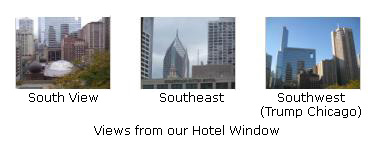
|
The room's window, which is right in front of the small desk, looked south towards Ontario Street and downtown. Fred and I took a number of pictures from this window while we were here. The ones we took today were cloudy and rainy, but the one that I took on Monday when we left was excellent. If you would like to look at any of the three best pictures we took from the room, just click on the appropriate thumbnail at right.
Saturday Evening in Chicago
We weren't able to do much this evening as the rain was pretty steady until we were coming back from dinner. We did get in touch with Gerry and arrange to meet him at his condo on Dearborn Street (more about his condo tomorrow), where we spent a good deal of time chatting and catching up. Then we walked from his condo about four blocks over to a new building on Michigan Avenue catty-corner across from the Drake Hotel. This building has a six-storey mall and then offices and residences above it. On level five there was an Italian restaurant that Gerry favors, and we had a really nice dinner.
Back at Gerry's condo, we made plans for the next afternoon (he had to be at his other condo in the morning for a delivery and installation of a big TV) and headed off back to the Holiday Inn Express.
You can use the links below to go to another album page.
 |
October 4, 2009: Chicago's Near North Side |
 |
October 1-2, 2009: The St. Louis Botanical Garden and Gateway Arch |
 |
Return to the Index for Our Midwest Trip |






